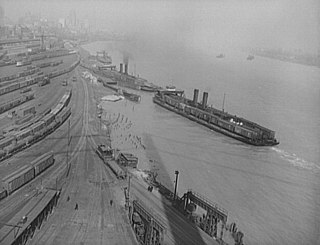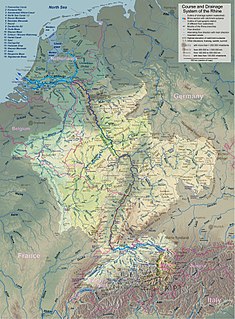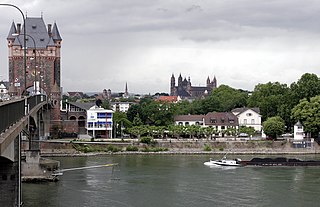
Mainz Hauptbahnhof, is a railway station for the city of Mainz in the German state of Rhineland-Palatinate. It is used by about 60,000 travelers and visitors each day and is therefore by far the busiest station in Rhineland-Palatinate. The station was a trial area for a CCTV scheme using automated face recognition.
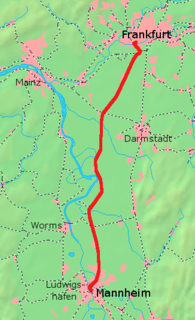
Mannheim–Frankfurt railway is a German standard gauge, electrified railway line and runs in southern Hesse and northern Baden-Württemberg between Frankfurt and Mannheim. It is also called the Riedbahn. The line runs through an area called the Hessische Ried, hence the name. The term Riedbahn was originally used for the Darmstadt–Worms railway and the two lines share the central section between Groß-Gerau and Biblis.
The Rhine-Neckar S-Bahn forms the backbone of the urban rail transport network of the Rhine Neckar Area, including the cities of Mannheim, Heidelberg and Ludwigshafen.

The Taunus Railway is a double-track electrified railway line, which connects Frankfurt and Wiesbaden, Germany. It is 41.2 km long and follows the course of the Main on its north side, running quite close to it in some places. Its first stage was opened in September 1839 and is thus the oldest railway line in the German state of Hesse and one of the oldest in Germany. Today it is used by Regional-Express trains between Frankfurt and Wiesbaden and the trains of line S1 of the Rhine-Main S-Bahn between Frankfurt-Höchst and Wiesbaden. Between Frankfurt Hbf and Frankfurt-Höchst, they run on the line of the former Hessian Ludwig Railway.
The Main Railway is a 37.5 km-long double-track electrified railway line, which runs on the south side of the Main River from Mainz to Frankfurt central station.

The Hessian Ludwig Railway or HLB with its network of 697 kilometres of railway was one of the largest privately owned railway companies in Germany.
The Rhine-Main Railway, is a railway line in southern Germany from Mainz via Darmstadt to Aschaffenburg. It was built by the Hessian Ludwig Railway and opened on 1 August 1858 and is one of the oldest railways in Germany. Until 1862, when the railway bridge over the Rhine river constructed and assembled by MAN-Werk Gustavsburg was finished, a train ferry operated on the river.

Bensheim station is in the town of Bensheim on the Main-Neckar Railway, connecting Frankfurt and Heidelberg, in the German state of Hesse. The station is also the beginning and end of the single-track non-electrified Worms–Bensheim line. 114 trains stop at Bensheim station every day, of which about one-third are long-distance services. It is classified by Deutsche Bahn as a category 3 station. Bensheim station is protected as a cultural monument under the Hessian heritage legislation.

Weinheim (Bergstraße) station is a station in the town of Weinheim in the German state of Baden-Württemberg. It is served by Intercity services on the Main-Neckar Railway between Frankfurt and Heidelberg/Mannheim. The Weschnitz Valley Railway (Weschnitztalbahn) to Furth in the Odenwald starts at Weinheim station. There is also a freight railway to Viernheim, the last remaining section of the former Weinheim–Worms railway.
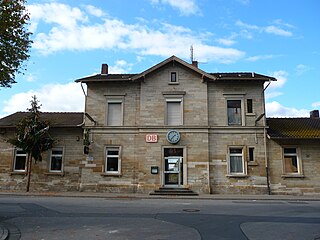
Riedstadt-Goddelau station, along with Riedstadt Wolfskehlen station, serves the town of Riedstadt in the south of the German state of Hesse on the Mannheim–Frankfurt railway and the Darmstadt–Worms railway. The station is classified by Deutsche Bahn as a category 4 station. It is served by local and S-Bahn trains.
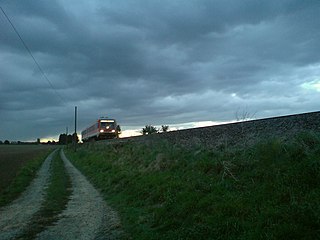
The Worms–Bingen Stadt railway or Rheinhessenbahn is a non-electrified line that links Worms via Alzey to Bingen Stadt in the German state of Rhineland-Palatinate.

The Hessian Ried is a low-lying, agricultural region that forms part of the northeastern area of the Upper Rhine Plain. It is situated in South Hesse in west central Germany.

The Western Entrance to the Riedbahn is a 9.5 km-long line in the Germany state of Baden-Württemberg, which was opened in 1985. It gives direct access from the Mannheim–Frankfurt railway from the north to the western end of Mannheim Hauptbahnhof, allowing trains to the east and the south to continue without reversal.

The Worms Rhine Bridge is a two-track railway bridge that spans the Rhine river to the north of Worms, Germany, forming part of the Worms–Biblis railway.
